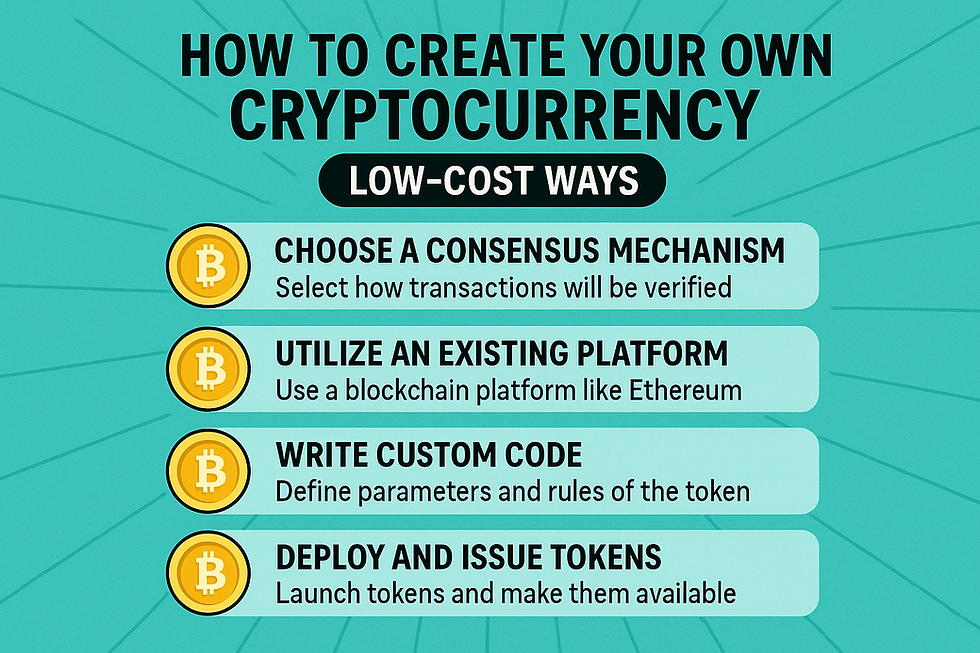Build Your Own Crypto Exchange with Low Investment: Here's How
- steveganger
- May 20
- 4 min read

In today's fast-growing cryptocurrency market, many aspiring entrepreneurs see a golden opportunity to create your own crypto exchanges. While the idea may feel overwhelming because of potential costs and technical challenges, it's entirely feasible to launch a crypto exchange with minimal investment. This guide will walk you through the essential steps, tools, and strategies to help you realize your dream.
Understanding the Basics of Crypto Exchanges
Before we dive into the steps of building your own exchange, let's clarify what a cryptocurrency exchange is and how it functions.
A cryptocurrency exchange is an online platform where users can buy, sell, and trade various cryptocurrencies. Think of it as a marketplace, where users can convert traditional money (fiat) into cryptocurrencies like Bitcoin and Ethereum, and vice versa. There are two main types of exchanges:
Centralized exchanges: Managed by a company and known for user-friendly features and high liquidity. For example, platforms like Binance handle millions of transactions daily and have a user base exceeding 50 million.
Decentralized exchanges: Allow users to trade directly with each other, removing the need for a middleman. An example of this is Uniswap, which operates entirely on the Ethereum blockchain.
Knowing these fundamentals can help you shape your exchange to meet the needs of your target audience effectively.
Key Steps to Build Your Own Crypto Exchange
Step 1: Define Your Business Model
Before getting into the technical details, you should outline your business model. Consider these questions:
What cryptocurrencies will you support? (e.g., Bitcoin, Ethereum, Litecoin)
Who is your target market? (e.g., institutional investors, casual traders)
What unique features will differentiate your exchange from others? (e.g., lower fees, advanced trading tools)
A clear business model not only guides your technical setup but also informs your marketing approach.
Step 2: Obtain Legal and Regulatory Compliance
Operating a cryptocurrency exchange requires strict adherence to legal regulations in your area. For instance, the US has regulations that vary by state, while countries in the European Union follow its own set of rules. You should seek counsel from legal experts on topics like:
Licensing requirements
KYC (Know Your Customer) protocols
AML (Anti-Money Laundering) guidelines
Proper preparation in this area can prevent costly legal issues down the line.
Step 3: Choose the Right Technology Stack
Your chosen technology stack profoundly affects your exchange's success. You have two primary options: build from scratch or utilize existing software solutions.
For those with limited coding experience, white-label solutions can be a viable option. These platforms often include features such as:
User management
Trading engine
Wallet integration
Admin panel
For instance, companies like AlphaPoint or Bitex allow you to set up an exchange with minimal technical hurdles. Evaluate these options based on budget, features, and scalability.

Step 4: Set Up System Architecture
After selecting your technology, design your system architecture. This includes detailing how different aspects of your exchange will work together:
Frontend: What users will see and interact with.
Backend: The server-side operations.
Database: Where user data and transaction history will be stored.
A thoughtful architecture can enhance performance and provide a better user experience, making this a critical step.
Step 5: Set Up Security Measures
Security should be your highest priority since users will trust you with their finances and personal data. Implement these security features:
Two-Factor Authentication (2FA)
Encryption for all data transmission
Cold storage for cryptocurrencies to keep them safe from hacks
Regular security audits to identify vulnerabilities
According to a report by CipherTrace, $4.8 billion was lost to crypto crime in 2021. Investing in robust security can not only prevent loss but also help you build trust with users.
Step 6: Integrate Payment Options
To enhance user experience, offer a range of payment options, including both fiat and cryptocurrencies. Partnering with reliable payment processors simplifies transactions. Think about options like:
Credit and debit cards
Bank transfers
Other cryptocurrencies
A seamless payment experience can significantly boost user engagement and retention.
Step 7: Launch and Market Your Exchange
Once everything is set, it's time to launch your exchange and attract users. Consider marketing strategies that could effectively raise awareness:
Leverage social media to reach your audience where they spend their time.
Engage with online communities such as forums or Discord groups dedicated to crypto.
Collaborate with industry influencers to promote your platform.
Utilizing effective SEO strategies can also increase your site's visibility and draw organic traffic.
Step 8: Monitor and Improve Continuous Improvement
After launching, your work is far from done. Regularly monitor user feedback, transaction patterns, and market trends to continually improve your platform.
Keep your software updated, fix any identified issues, and adapt to evolving user needs. Continuous refinement helps maintain competitiveness in this fast-changing industry.
The Path Ahead
Creating your own crypto exchange is both challenging and rewarding, even with limited investment. By grasping the basics and following these actionable steps, you can establish a platform that attracts traders and investors alike.
From defining your unique business model to implementing rigorous security protocols, each step contributes to building a successful exchange. The journey is intricate, but with diligent planning and execution, you can carve out your space in the thriving cryptocurrency landscape.
Begin your preparations today, and you may soon find yourself leading in this exciting domain. Remember, success hinges on detailed planning, legal compliance, technology adoption, and unwavering focus on user experience. Embrace this challenge and start building your crypto exchange!



Comments